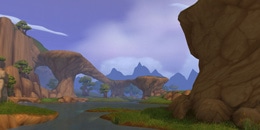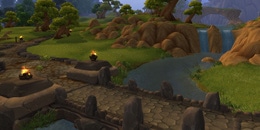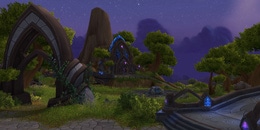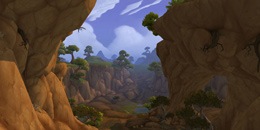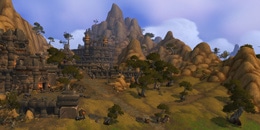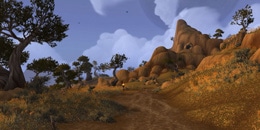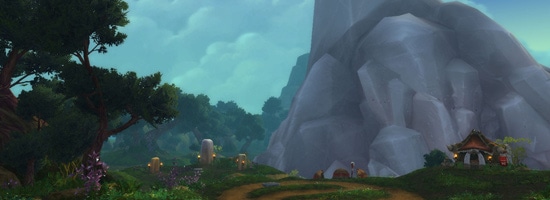Hi, I’m Chris Robinson, senior art director of World of Warcraft. In this last installment of this four-part Artcraft series, WoW community manager Bashiok sat down with a few of the level designers who created Nagrand to pick their brains a bit more on the process of creating the zone.

Hey everyone—so for all the peoples out there, go ahead and introduce yourselves, and for fun, name a zone you’ve worked on in the past.
Victor: Hi, I’m Victor Chong, senior level designer, and people probably remember Vale of Eternal Blossoms in Pandaria.
Ian: I’m Ian Gerdes, level designer on World of Warcraft, and the zone I was probably most involved with in Mists [of Pandaria] was Isle of Thunder.
Ed: I’m Ed Hanes—I’ve been at Blizzard for 13 years, and the first zone I ever worked on was Ghostlands for The Burning Crusade expansion.
Kevin: I’m Kevin Lee, a four-year vet here at Blizzard, and I worked on the Jade Forest in Pandaria.
Damarcus: Hey there I’m Damarcus Holbrook. I’m the new guy, so all my focus has been on Warlords; specifically for this discussion, the exterior of the Highmaul Raid in Nagrand.
What were some of the specific challenges you had with creating Nagrand?
Ian: I think a lot of it was trying to preserve the original layout as much as we could. Nagrand was kind of the one zone that was never really as wrecked as the other zones were from being shattered. It’s kind of blue skies and green trees, and there’s not fel energy everywhere. So I think trying to preserve some of the landmarks and maintaining the spaces was something we really wanted to make sure remained intact—while still making sure it feels new to the player.
So you obviously had to do some translation of the Outland version. How did you decide how to fill in the areas that were previously destroyed?
Ian: We wanted to preserve some of the silhouette on the world map, so that it still felt familiar. I know Tanaan Jungle was similar in some respects where the edges were broken away, but we still wanted to retain what was Hellfire Peninsula. It was the same for Nagrand. We had a little bit of freedom, however, because there were some parts of the zone that were more obviously destroyed than others, like the southern edge of Oshu’gun and the western border. There were some ogres hanging out there, but nothing substantial in terms of structure, so we decided to add the Raid over there, because it felt like it would be a good extension of the story that fit with the timeline. It ended up getting quite a bit bigger than we had originally planned for. It’s pretty impressive as a zone point of interest (POI) that you can see from a distance, and really breaks up the skyline.
Ed: The biggest challenge was giving a fresh look to something players are familiar with. It’s definitely a zone that players who had that experience in Burning Crusade know; there’s a defined image that comes to mind of what that zone is and what it’s about. A lot of people remember the Nesingwary stuff—the sweeping plains, the angular trees, the floating rock islands, the Throne of Elements. It was one of those zones that was around where a lot of people were hitting their max level, and so it’s got that association with it as well. So that was a huge challenge, figuring out how to keep it fresh while keeping it familiar.
Any stories from Outland people might remember represented in this new old Nagrand?
Ian: On the mountain range north of Nagrand, in the Burning Crusade version, as you were going to Zangarmarsh there was an orphanage that...
Victor: Yeah...
Ian: ...it was a little... creepy. There’s an NPC there, and I think they’ll be making a return. I actually just put a cage in at the Burning Blade POI today, so I’ll be talking to [the quest team] to see if they want to do anything with that. Corki was certainly one of the more memorable quest lines in Nagrand.
Victor: The Ring of Blood is coming back. It’s a bit more upgraded, but the visual style is very similar.
So you put a cage there, but want to go talk to the quest designers. How does that work as far as who is designing what? How much of it is your team coming up with the story of an area, and how much of it is the quest team bringing it in?
Ian: It’s bi-directional. Sometimes we’ll have a cool idea and they’ll latch onto it, and sometimes they’ll have the cool idea and we’ll latch onto it. It’s definitely a partnership.
Victor: We spend a lot of time with the quest designers, specifically on coming up with really interesting ideas. This expansion specifically is doing a lot of vignette stuff...
Sorry, what’s a vignette?
Victor: It’s an internal term we use for a cool little area or thing you stumble across, something that’s not necessarily part of the main quest line. We’re putting a lot more Easter eggs into the zones this time around, so it doesn’t matter if players find them or not...
Ian: But it’s cool for them if they do.
Victor: We’ve added a lot more vignette stuff, and I was working with Kurt Sparkuhl, a quest designer, on how I could add hidden stuff on the tops of mountains. So we have a lot of vignettes where players have to figure out how to get up there without just being able to walk up. It’s stuff like doing some jumping around to get into an area, and then when you get to the top, you find a goblin with a glider that’ll let you glide to specific areas that aren’t normally accessible. Then if you get through all of that and land on a specific spot, you’re rewarded with whatever the prize is there from a chest or something. We’re doing a lot of that, and Nagrand was a good test bed for those kinds of things.
What’s your favorite area or detail in the zone?
Victor: There are a lot of very cool things we did in Nagrand. For me specifically I did the whole canyon area, so there’s like three big canyons within the zone.
Ian: And that’s kind of a callback to the original zone. . . .
Victor: We originally weren’t even planning to do that stuff.>
Ian: It was kind of an iteration of the process, because we had originally gone super crazy with the rolling hills, which looked fantastic, but we needed something to break it up.
Victor: That’s actually kind of an interesting story. The first thing that comes to mind for Nagrand was the rolling hills, and the big open grass areas where you were just killing animals—that was a lot of fun and really stood out to me. I started doing a very elaborate rolling hill layout, where every hill is perfectly molded and you have these perfect views of the zone from every angle. Most of the level designers thought it looked great, but when the quest designers looked at it they thought, “What are we going to do with all this open space?” and it didn’t work—it was just too big of an open area. And so when you start looking at the elements of the zone there are trees everywhere, and I think [lead quest designer] Craig Amai said that what he remembered wasn’t the rolling hills, but the canyons, which was surprising to me. Turns out, it was actually a zone full of canyons. It got me thinking about why I never really remembered these canyons, and looking back it’s that they were pretty bad; there wasn’t really any good gameplay there. Spawns were far apart, they were very narrow, and if you accidentally fell down into one they were just this annoying trap you couldn’t find your way out of. So I looked at what I could do to make them better—made them wider, added multiple sub-zones within them, and added more pathways in and out of them. They turned out really well and we ended up adding two more of them.
What do you want players to experience when they enter Nagrand for the first time?
Victor: I’d like them to see that it’s familiar, but that this is definitely a different time, and that the Warsong clan is here. This is their place.
Ed: Familiar but new. It’d be awesome for people to feel like it’s familiar, but that there’s a lot of new stuff, that it’s a new experience and not just the old Nagrand that’s just been touched up a little.
Could you tell us more about some of the POI’s, how they developed, and what kinds of inspirations were taken from inside and outside of World of Warcraft?
Let’s start with the Warsong clan camp.
Ian: The idea originally was that the Warsong were nomadic, and seasonally would move from the highlands to the lowlands. The idea being that the flood plains would indeed flood, they wouldn’t want to hang out there, and they’d move up to higher ground.
Victor: We ended up using the canyon to illustrate that while their city is both nestled in the canyons and up above them, it still feels like a cohesive city. There’s a river that goes through the entire center of town, but it’s dried out, and it’s supposed to show that when it’s the rainy season it would fill up, so we still tried to pull off that same feeling. We also have where Garrosh is supposed to be sitting in his throne there.
How about the Highmaul Ogres? How did they influence the zone, and how did you try to create a sense of history?
Ed: They were originally supposed to be in the background of the Warsong. However, as the kit was developed, we had a bigger and stronger art push on the look of those guys, and they became a much bigger presence in the zone. Now most of the max level content is focused around them, with that kit being so robust that we were also able to use it in other zones. Their culture actually expanded, I think, as people got on board and dug the vibe of this kind of elevated status of ogre society and their seat of power, and it spread across the expansion.
Ian: Yeah, I think the idea for them was kind of the twilight of the Roman Empire, where their society used to be very grand, and you kind of see how it’s devolving as you look at Frostfire and the Stonemaul. Kind of how ogre society is getting more brutish and less sophisticated and the Highmaul are this last remnant of what they were, or what the Highmaul still are.
Victor: It’s interesting too, because when we first started it was all Warsong—we had this giant Warsong warpath, this giant road, and then we ran into what we called orc fatigue, where the entire expansion just had too much orc. Which fits thematically and makes logical sense, but from a gameplay standpoint gets boring really quickly. So in that process the ogres got elevated quite a bit.
Ian: You get kind of a layered history too, where the ogre empire used to reach across all of Draenor—but over time it’s deteriorated, other races have moved in, and so Victor did a really nice road treatment where you have the sort of ancient and broken ogre tiles, with the newer Warsong paths crisscrossed on top of it.
Ed: And we knew we were going to have the Highmaul Raid, and so once the art started taking shape for that we were able to pull pieces out of it—like this wall or column looks really cool—and were able to use a lot of that to build out their story in the exterior environment.
Tell us more about the Highmaul Raid.
Damarcus: It’s the stronghold, the final stand for the ogres to hold their ground. The orcs are pushing against them, but they’re holding out. You and your friends roll up through their arena first, and you get some cool options on how you want to progress through the first few bosses before you get into the big keep.
Ian: It’s a little less linear than newer raids have been, so it’s kind of a throwback to that old style of non-linear raids and choosing which way you go and which bosses you want to kill in what order.
So is it as open as, say, Firelands?
Damarcus: Actually, so this was the first thing I really got to work on at Blizzard. I ended up making the exterior areas of the Highmaul raid and working with the team who made Firelands—so I looked at that a lot and worked with them on how exterior design works for raiding. Ed and I jammed on layout a bit and we kind of thought a triangular layout would work best where you hit the first boss, and then have three options before coming back in before you get to the keep itself. The layout itself works really well.
What’s about Oshu’gun?
Ed: Kevin is really the guy who worked on a lot of it, but we knew it was one of those parts of Nagrand that we needed to keep. We also of course wanted to do something different with it, and one of the things we pitched early that stuck was to give it to the orcs. They’re there right now, but before that, there was a nice forest wrapping around it, and there are still some remnants of the impact when it crashed into Draenor.
Kevin: We wanted to draw on the crater vibe, to make it look a bit more raw—like this had happened recently versus how it looked in Outland. We also wanted to still have some of the runes around it kind of for the nostalgia factor because that’s how we all remember it looking. You can also go inside of it as part of a quest chain, and into an orc cave inside. It’s one of the main quest story lines and will have a lot more meaning to people when they play through it.
Finally, tell us about the Throne of Elements.
Ian: We really wanted to try to preserve a lot of it. Originally we had it elevated, where it was halfway between the top of the mountains and the lake surface, and the idea was that with the destruction of Draenor, it crashed into the lake. But it blocked the shot of the iconic waterfalls behind it, and there were some other technical constraints, so it ended up more as how we all remember it. Also up top on the Elemental Plateau where people probably remember farming motes, there were elementals kind of sharing a space, but we wanted to break that out into four distinct areas where each is represented. So for the fire area, the ground is all dried out and scorched, the water elemental section is where the waterfalls are up above the throne, and the earth and air sections are nearby.
Ed: Real estate–wise it commands a bigger presence than it did previously, for sure.
Hey there, Chris again. So this wraps up this exterior level design series, but this is by no means the end of the line. We hope that we’ve been able to provide a bit more insight on what it takes to create a zone in World of Warcraft, and look forward to seeing you make your way into Draenor. We’ve put a lot into trying to create some truly epic environments and experiences for those of you who take up the challenge of fighting back against the Iron Horde. Until next time, thanks for reading!




